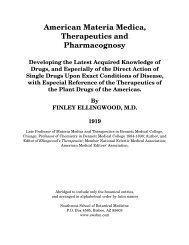SCARLET FEVER. Synonyms.—Scarlatina; Scarlet Rash. Definition ...
SCARLET FEVER. Synonyms.—Scarlatina; Scarlet Rash. Definition ...
SCARLET FEVER. Synonyms.—Scarlatina; Scarlet Rash. Definition ...
Create successful ePaper yourself
Turn your PDF publications into a flip-book with our unique Google optimized e-Paper software.
great nervous irritation.<br />
For the myalgia, macrotys, rhamnus Californica, and bryonia will be<br />
used, and for the lymphatic involvement phytolacca will be the remedy.<br />
Jaborandi may be useful during the active stage of the fever.<br />
Of course, quinia will be used if the patient resides in a malarial section<br />
and if periodicity exists.<br />
THE PLAGUE.<br />
<strong>Synonyms</strong>.—Bubonic Plague; Pestilence, or Pest; Black Death; Plague<br />
of Egypt.<br />
<strong>Definition</strong>.—A specific, infectious, and contagious disease of peculiar<br />
intensity, rapidly running its course, and characterized by inflammation<br />
of the glands (buboes), carbuncles, ecchymoses, and petechise upon the<br />
surface. It is endemic on the eastern coast of the Mediterranean Sea and<br />
the Oriental countries adjacent. Epidemics occur when it spreads to<br />
other parts of the world, traveling along the great thoroughfares of<br />
travel and commerce.<br />
History.—The plague is a very old disease, and probably epidemics<br />
raged and devastated peoples centuries before we had any authentic<br />
accounts. Sacred and profane histories speak of pestilences which<br />
ravaged the Valley of the Nile and the Plain of Philistia. Greece was<br />
severely visited, and Athens lost nearly a third of her population four<br />
hundred years B. C. Many believe that these “visitations” were none<br />
other than the plague.<br />
The earliest positive knowledge that we have of the disease dates from<br />
the epidemic which occurred in the sixth century, beginning in Egypt in<br />
542, and extending to Palestine, Syria, and Persia; passing thence into<br />
Asia Minor, then on into Europe, carrying off, at Constantinople, ten<br />
thousand victims in one day (543 A. D.). Becoming pandemic, it spread<br />
in every direction. It is estimated that fifty per cent of the inhabitants of<br />
the Eastern Hemisphere died, either directly or indirectly, from this<br />
great epidemic before the close of the sixth century.<br />
The next great epidemic was the irresistible march of the “Black Death”<br />
The Eclectic Practice of Medicine - PART I - Infectious Diseases - Page 229

















